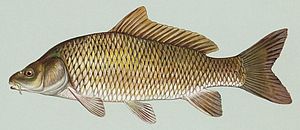Spring Natural History Note – Fish Spawning

Early spring to mid-summer offers opportunities for observing spawning behavior in many of the small common fish species of Lake Champlain. There are about 28 minnow species that occupy the lake ranging from tiny shiner species that rarely get more than 2.5 inches long to the common carp which may grow up to 25 pounds. Each species has distinctive habits and behaviors. According to Inland Fishes of New York:
“Minnows lay their eggs on or in the bottom, in algae or other aquatic plants or the male may build and protect a nest.
Three general types of nests are constructed by minnows. First, there are nests consisting of piles of stones (carried by mouth to the nest); second, circular or cup-shaped depressions in or above riffles; and third, excavations under a stone, allowing the eggs to be attached to the underside of the stone.
Nests of more or less circular piles of stones are the easiest to identify, occurring either in fairly quiet waters or in riffles. These nests are built by the male, which carries the stones by mouth. Fallfish, chubs (Hybopsis spp.), and cutlips minnows build nests of this type. Fallfish nests have been measured as large as 6 feet in diameter and 3 feet high. Constructed with flat stones averaging 2 inches in diameter, fallfish nests usually have a keel-like crest, which may lie either crosswise or with the current. Chub nests average 2½ feet in diameter and are built up 6 to 12 inches. The cutlips minnow uses small pebbles to build nests about 10 to 18 inches in diameter.
Circular or cup-shaped depressions are excavated by the pit-digging minnows to receive the eggs. The stoneroller minnow, the creek chub, and the common shiner build this type of nest. Two to five male stonerollers work together on a single pit at the downstream end of a pool. They remove material by thrusting their snouts into the gravel and jerking their heads sideways. Stones are occasionally picked up in the mouth and carried upstream. Depressions are up to a foot in diameter. Males fight continually during the operation, even to the point of blinding one another with their breeding tubercles."
